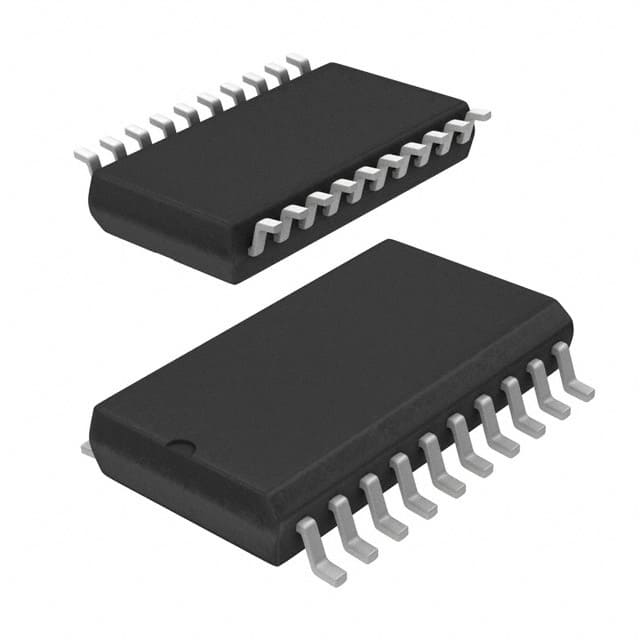Encyclopedia Entry: 74ACT299MTR
Product Overview
Category
The 74ACT299MTR belongs to the category of integrated circuits (ICs) and specifically falls under the family of flip-flops.
Use
This IC is primarily used for data storage and transfer applications in digital electronic systems. It provides a convenient way to store and retrieve binary information.
Characteristics
- The 74ACT299MTR is a 8-bit universal shift/storage register.
- It operates on a wide voltage range, typically between 2V and 6V.
- This IC offers high-speed operation, making it suitable for applications requiring quick data transfer.
- It has a compact package size, allowing for easy integration into various electronic devices.
Package and Quantity
The 74ACT299MTR is available in a small outline integrated circuit (SOIC) package. Each package contains one IC.
Specifications
- Supply Voltage Range: 2V to 6V
- Operating Temperature Range: -40°C to +85°C
- Input/Output Compatibility: TTL, CMOS
- Maximum Clock Frequency: 100 MHz
- Number of Pins: 20
Pin Configuration
The detailed pin configuration of the 74ACT299MTR is as follows:
- Q0
- D0
- D1
- D2
- D3
- D4
- D5
- D6
- D7
- GND
- CP
- DS
- SH/LD
- MR
- OE
- Q7
- Q6
- Q5
- Q4
- VCC
Functional Features
- The 74ACT299MTR can operate in parallel or serial mode, providing flexibility in data transfer.
- It supports both synchronous and asynchronous data loading.
- This IC offers a master reset function, allowing for easy initialization of the register.
- The output enable feature enables/disable the outputs as required.
Advantages
- High-speed operation allows for efficient data transfer.
- Wide voltage range compatibility makes it suitable for various electronic systems.
- Compact package size facilitates integration into space-constrained designs.
- Versatile functionality with parallel and serial modes enhances its usability.
Disadvantages
- Limited number of bits (8-bit) may not be sufficient for certain applications requiring larger data storage.
- The small outline package may pose challenges in manual soldering or rework processes.
Working Principles
The 74ACT299MTR operates based on the principles of flip-flops. It utilizes clock signals to synchronize the transfer of data between input and output registers. The shift/load control determines whether the data is loaded in parallel or shifted in serially. The master reset function resets the register to a predefined state.
Application Field Plans
The 74ACT299MTR finds application in various digital systems, including but not limited to: - Data communication equipment - Microcontrollers - Memory modules - Industrial automation systems
Alternative Models
Other alternative models that provide similar functionality to the 74ACT299MTR include: - 74HC299 - CD74HCT299E - SN74LS299N
In conclusion, the 74ACT299MTR is a versatile 8-bit universal shift/storage register IC. Its high-speed operation, wide voltage range compatibility, and compact package make it suitable for various digital electronic applications. However, its limited bit capacity and potential challenges in manual soldering should be considered when selecting this IC for specific projects.
Word Count: 457
Lista 10 Vanliga frågor och svar relaterade till tillämpningen av 74ACT299MTR i tekniska lösningar
Sure! Here are 10 common questions and answers related to the application of 74ACT299MTR in technical solutions:
Q: What is the 74ACT299MTR? A: The 74ACT299MTR is a 8-bit universal shift/storage register with 3-state outputs, commonly used in digital circuits.
Q: What are the key features of the 74ACT299MTR? A: The key features include parallel-to-serial or serial-to-parallel data conversion, 3-state outputs for bus-oriented applications, and synchronous operation.
Q: How does the 74ACT299MTR perform parallel-to-serial data conversion? A: The 74ACT299MTR has an 8-bit parallel input that can be loaded into the internal shift register and then shifted out serially.
Q: Can the 74ACT299MTR be used for serial-to-parallel data conversion? A: Yes, the 74ACT299MTR can also be used to convert serial data into parallel format by shifting in the data serially and then latching it into the parallel output registers.
Q: What is the maximum clock frequency supported by the 74ACT299MTR? A: The 74ACT299MTR can operate at a maximum clock frequency of typically 125 MHz.
Q: Does the 74ACT299MTR support 3-state outputs? A: Yes, the 74ACT299MTR has 3-state outputs which allow multiple devices to share a common bus without interfering with each other.
Q: What is the power supply voltage range for the 74ACT299MTR? A: The 74ACT299MTR operates with a power supply voltage range of 4.5V to 5.5V.
Q: Can the 74ACT299MTR be cascaded to increase the number of bits? A: Yes, multiple 74ACT299MTR devices can be cascaded together to increase the number of bits in the shift register.
Q: What is the typical propagation delay of the 74ACT299MTR? A: The typical propagation delay of the 74ACT299MTR is around 6 ns.
Q: What are some common applications of the 74ACT299MTR? A: The 74ACT299MTR is commonly used in applications such as data storage, serial data communication, parallel-to-serial conversion, and vice versa.
Please note that the answers provided here are general and may vary depending on specific datasheet specifications and application requirements.


